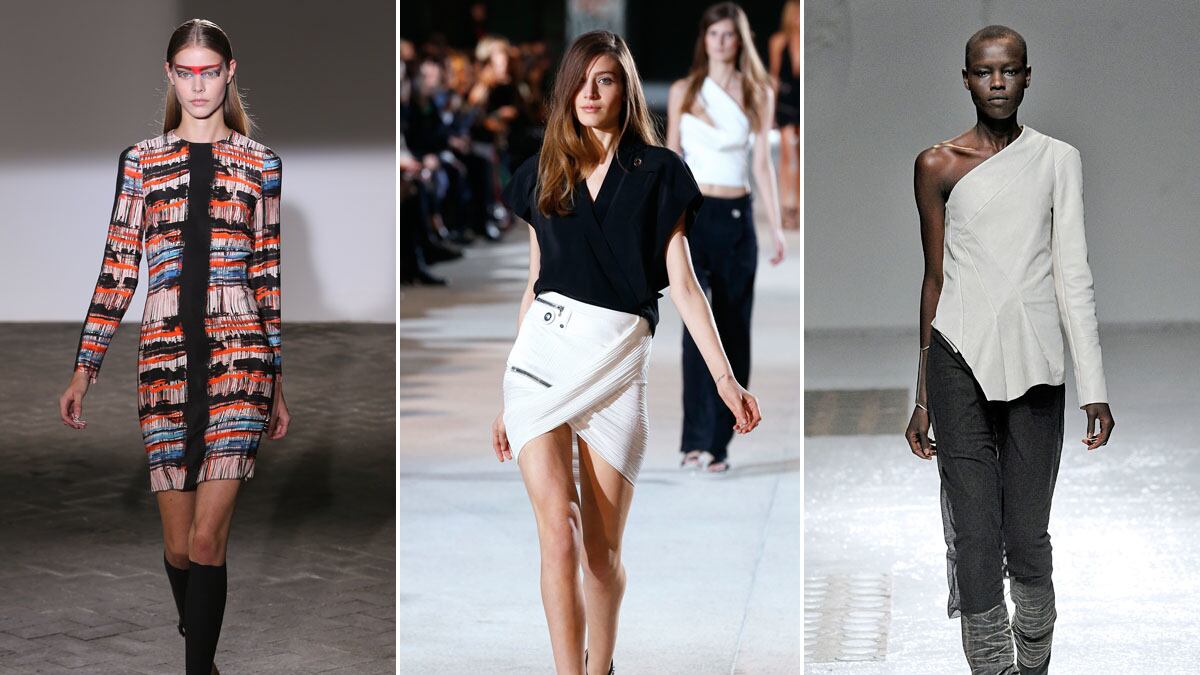
The spring 2013 shows began quietly in Paris with presentations by a handful of rising designers who are not yet big brands but who are essential to this city’s reputation as a place of endless creative possibilities.
Designers such as Cédric Charlier, Anthony Vaccarello, and Nicolas Andreas Taralis underscored the wildly divergent aesthetics that comprise the city's fashion industry and its cultural definition of femininity. Charlier focused on a linear silhouette that was grounded in the enduring philosophy of restraint. Vaccarello is unabashed in his embrace of a rather dubious version of sex appeal, with draped, thigh-skimming skirts that came staggeringly close to revealing the private parts of the models as they walked down the runway. To be sure, fashion does not need to join feminist literature in a meditation on the vagina.
And Taralis offered a thought-provoking assessment of gender and what it means to be feminine or masculine when so much about traditional roles has long been upended.
The Paris fashion industry will, of course, always have its great traditions and grand houses. They are part of the cultural DNA of Europe. But someone must keep those engines churning with new ideas and fresh bravado. Indeed, the European Commission recently unveiled a kind of economic improvement blueprint that specifically highlights the importance of the luxury design industry to the future of the European Union. Underscoring the success of the corporate goliath of luxury fashion, LVMH Moet Hennessy Louis Vuitton, the report took note of fashion's economic impact and its cultural importance. LVMH responded with a statement encouraging the EU to focus on apprenticeships to teach young people the crafts of tailoring, embroidery, and so on.
The future of Paris fashion is an often-discussed topic these days, not only in the halls of government—and not because it is in danger. But change is afoot. Emanuel Ungaro recently announced the signing of a new designer, Fausto Puglisi, who may be able to put the storied brand back together after a series of designers came and went in the wake of the founder’s retirement. (The brand was dealt a near death blow in 2009 when executives brought in Lindsay Lohan as an artistic adviser.) The Spring season also brings major ready-to-wear debuts at the venerable houses of Christian Dior and Yves Saint Laurent—recently rebranded as just Saint Laurent Paris. Raf Simons will unveil his first ready-to-wear collection at Dior and Hedi Slimane will mount his first show at Saint Laurent.
Both men have been heavily influenced by popular culture and are known for injecting a sense of modern energy into their designs. How they will bridge the divide between the history and traditional techniques of their respective houses and the reality of contemporary times is the question that fuels industry anticipation.
With the rise of each new designer or designer collaboration, the singular question is always: how will this move fashion forward?
There are no clear paths being advocated by this generation of designers. Charlier has a fine eye for color—although he focused most of his energy for spring on the clean lines of ivory dresses draped subtly through the torso and jackets slashed with copper-colored zippers.
Vaccarello is interested in a supremely sexy silhouette in which backless shirts are just barely held onto the body with a single strap that encircles the torso. Skirts and dresses are cut so that they constantly threaten near nudity. It takes great skill to pull off that sort of seduction and often the frocks were so awkwardly constructed that they suggested a more mundane striptease. His finale gown, a one-sleeved black caftan that left one leg on display—call it a half-tan--was technically intriguing but aesthetically jarring.It wasn’t a collection that sparked cheering, but it left one curious. With his sexy tailored blazers and luxe brocades, which were superb, one wanted to see more. What is this fellow up to?
It was ultimately the Toronto-born Taralis who offered the most compelling thoughts about how women—and men—might dress. His palette was black and white, with a bit of murky gray mixed in. And he often layered long shirts over skinny trousers or slender shorts. He used translucent fabrics to suggest nudity without ever really revealing very much. He pinched the shoulders of jackets and dresses into little mountain peaks, creating height, but never unruly width.
There was never anything traditionally glamorous about his models. They looked as though they had arrived for work without a proper shower—or at least one during which water and shampoo came into contact with their hair.
There was nothing beautiful on Taralis’s runway—not in the pretty-girl and handsome-guy way in which fashion typically traffics. There were whiffs of the painfully “hipster” sensibility in which everything is a bit bedraggled and self-consciously messy. But mostly there was a quiet soulfulness to the collection in which tight leather jeans and black tanks were followed by filmy white chiffon dresses that were positively angelic.
The men wore long layers, too, often over their shorts. There was little that really distinguished the menswear from the women’s. But unlike the usual depiction of androgyny, in which women are defeminized, Taralis allowed men to reveal their softer side. Men and women moved equally toward the middle without becoming caricatures. Gender wasn’t obliterated. On his runway, masculinity and femininity had simply reached parity.






